As an important special equipment for oil drilling, slotted casing has a relatively simple manufacturing process. The material of slotted casing is mainly petroleum casing and tubing, and petroleum casing is basically used as the raw material for making slotted casing. There are three main types of slotted casing arrangements: parallel seams, cross seams, and group seams. When making, the sewing edges need to be vertical, the cutting edges should be smooth and burr-free, and the cutting seams should be even. Slotted casing is a type of pipe made by cutting a series of gaps in the pipe wall. It is mainly used for sand control and filtration in oil and gas wells. It is designed to allow oil and gas to pass smoothly while blocking formation sand from entering the well, thereby protecting the wellbore and equipment and extending the service life of the oil and gas well. With the acceleration of the transformation process of old wells in petroleum engineering, the use of slotted casing for well completion is currently the first choice in the sand control technology of sand reservoirs, which further increases the demand for slotted casing. Slotted casing will gradually replace wire-wound screens and become the mainstream product in the market. In a certain period of time, the market demand for slotted casing may increase, and many small and medium-sized enterprises will enter the industry, making the competition for slotted casing increasingly fierce. fierce.

Slotted casing is a kind of sand control screen pipe with a certain width of thin cracks processed on the casing or oil pipe body, and the large sand particles carried in the formation fluid are blocked outside the pipe body by the thin cracks to achieve the function of sand and oil seepage.It mainly has the following four technical characteristics:
① The pipe and seam of the slotted casing are in one body, with a single-layer overall structure and a larger inner diameter;
②Simple structure and low processing difficulty;
③Adopting advanced laser cutting seams, the seam width is uniform and the precision is high;
④ Low cost and wide applicability. The sand control string can be used not only for the sand control of all kinds of oil, gas and water Wells completed by casing Wells such as straight Wells, inclined Wells, side drilling and horizontal Wells, but also for the oil and water Wells of the above types of reservoirs completed by open hole drilling.
Technical innovation of slotted casing
The continuous innovation of slotted casing technology has brought many advantages to oil and gas production. Modern slotted sleeves use advanced laser cutting technology and high-precision machining to make the shape, size and distribution of gaps more precise, significantly improving the filtration effect and durability of the screen.
Laser cutting technology: Laser cutting technology makes the gap precision of slotted sleeves higher and the cutting edge smoother, reducing burrs and irregularities caused by traditional cutting methods.
High-strength materials: Modern slotted casing is usually made of high-strength alloy steel or stainless steel, which improves the corrosion resistance and mechanical strength of the slotted casing and adapts to more complex geology and mining environments.
Automated production line: The introduction of automated production lines improves production efficiency and product consistency, ensuring that each slotted casing has high-quality filtration performance.
Currently, most of the slotted casings used in oil fields are rectangular, single trapezoidal seam, or combined seam screens. No matter which seam type screen tube has its advantages and disadvantages, for example, rectangular seams can easily cause sand blockage and reduce the oil pumping effect. , but it still occupies part of the market due to its advantages of low cost and easy processing. The ladder seam pipe overcomes the shortcomings of the rectangular seam and has a strong "self-cleaning" effect. It also has the advantages of small flow pressure loss and long life. However, the single trapezoidal seam screen tube has a sharp seam due to its large angle. Under the abrasive effect of the extracted materials, it is easy to cause problems such as sharp corner damage and increased joint width. In terms of the above, a single fracture type may not be able to meet the more complex underground environment in the future, so composite fracture cavities will definitely be the development method of slotted casing in the future. The composite joint cavity should be composed of trapezoidal joints with smaller angles, transitional quadratic curve joints and trapezoidal joints with larger angles. The outer trapezoidal seam of the screen tube has a very small angle and a thickness of 2-3mm. This structural design can not only keep the seam cavity open but also reduce the abrasion of the sharp corners of the seam opening. The quadratic curve on the inner wall of the tube and the large-angle trapezoidal slit can greatly reduce the flow resistance of the slit to crude oil, which can effectively extend the service life of the screen tube while increasing production.
In recent years, strong oil prices have revived activity in upstream oil and gas exploration and production, which will undoubtedly bring sustained benefits to exploration and drilling equipment companies. Petroleum exploration and drilling equipment mainly refers to special equipment for oil and gas exploration, drilling, development, storage and transportation, specifically including geophysical and logging equipment, drilling equipment, oil and gas production equipment, downhole operation equipment, oil and gas gathering and transportation equipment, and ocean drilling equipment. Purchase platform equipment, etc. and related accessories and tools. Currently, most of these devices have certain capabilities, and many listed companies are involved. The background here is long. The market for slotted casing manufacturing is also promising.






 English
English Español
Español بالعربية
بالعربية











 Phone :
Phone :  Whatsapp :
Whatsapp :  Email :
Email : 


